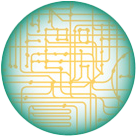Cryosectioning-Enabled Super-Resolution Microscopy for Studying Nuclear Architecture at the Single Protein Level
Authors:
Johannes Stein1,2*, Maria Ericsson3, Michel Nofal1, Lorenzo Magni1, Sarah Aufmkolk2, Ryan McMillan1, Laura Breimann2, Conor Herlihy2, S. Dean Lee2, Andréa Willemin4,5, Jens Wohlmann, Laura Arguedas-Jimenez4, Peng Yin1, Ana Pombo4,5, Chao-ting Wu2, George M. Church1,2
Institutions:
1Wyss Institute for Biologically Inspired Engineering; 2Department of Genetics, Harvard Medical School; 3Blavatnik Institute, Harvard Medical School; 4Max Delbrück Center for Molecular Medicine in the Helmholtz Association, Berlin Institute for Medical Systems Biology Epigenetic Regulation and Chromatin Architecture Group; 5 Institute for Biology, Humboldt-Universität zu Berlin; 6Department of Biosciences, University of Oslo
Abstract
DNA points accumulation for imaging in nanoscale topography (DNA-PAINT) combined with total Internal Reflection Fluorescence (TIRF) microscopy enables the highest localization precisions, down to single nanometers in thin biological samples. However, most cellular targets, including the nucleus, elude the accessible TIRF range close to the cover glass and thus require alternative imaging conditions, affecting resolution and image quality. Here, researchers address this limitation by applying ultrathin physical cryosectioning in combination with DNA-PAINT. With “tomographic and kinetically enhanced” DNA-PAINT (tokPAINT; Stein et al. 2024), the group demonstrates imaging of nuclear proteins with sub-3 nanometer localization precision, advancing the study of nuclear organization within fixed cells and mouse tissues at the level of single antibodies. This team believes ultrathin sectioning combined with the versatility and multiplexing capabilities of DNA-PAINT should be able to contribute to the study of proteins, RNA, and DNA in genome organization at the molecular level and in situ.
References
Stein, J., et al. 2024. “Cryosectioning-Enabled Super-Resolution Microscopy for Studying Nuclear Architecture at the Single Protein Level,” bioRxiv. DOI:10.1101/2024.02.05.576943.
